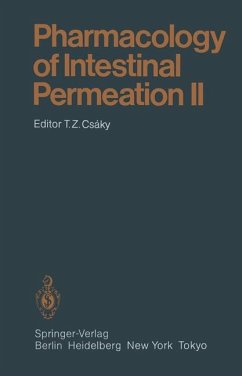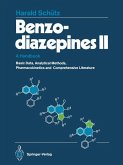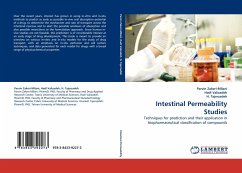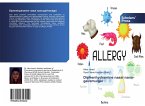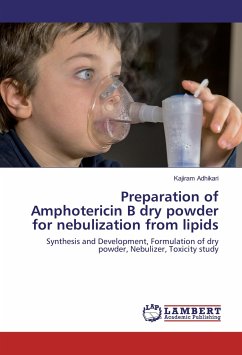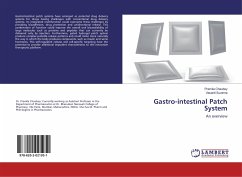Pharmacology of Intestinal Permeation II
Mitarbeit:Banwell, J.G.
Pharmacology of Intestinal Permeation II
Mitarbeit:Banwell, J.G.
- Broschiertes Buch
- Merkliste
- Auf die Merkliste
- Bewerten Bewerten
- Teilen
- Produkt teilen
- Produkterinnerung
- Produkterinnerung
The intestine, particularly the small bowel, represents a large surface (in the adult 2 human approximately 200 m ) through which the body is exposed to its environ ment. A vigorous substrate exchange takes place across this large surface: nutrients and xenobiotics are absorbed from the lumen into the bloodstream or the lymph, and simultaneously, the same types of substrate pass back into the lumen. The luminal surface of the intestine is lined with a "leaky" epithelium, thus the passage of the substrates, in either direction, proceeds via both transcellular and intercellular routes. Simple…mehr
Andere Kunden interessierten sich auch für
![Benzodiazepines II Benzodiazepines II]() Harald SchützBenzodiazepines II79,99 €
Harald SchützBenzodiazepines II79,99 €![Intestinal Permeability Studies Intestinal Permeability Studies]() Parvin Zakeri-MilaniIntestinal Permeability Studies46,99 €
Parvin Zakeri-MilaniIntestinal Permeability Studies46,99 €![Diphenhydramine nasal nano-gel/emulgel Diphenhydramine nasal nano-gel/emulgel]() Hina JavedDiphenhydramine nasal nano-gel/emulgel31,99 €
Hina JavedDiphenhydramine nasal nano-gel/emulgel31,99 €![Practical manual of Biopharmaceutics & Pharmacokinetics Practical manual of Biopharmaceutics & Pharmacokinetics]() Haranath ChinthaginjalaPractical manual of Biopharmaceutics & Pharmacokinetics27,99 €
Haranath ChinthaginjalaPractical manual of Biopharmaceutics & Pharmacokinetics27,99 €![Preparation of Amphotericin B dry powder for nebulization from lipids Preparation of Amphotericin B dry powder for nebulization from lipids]() Kajiram AdhikariPreparation of Amphotericin B dry powder for nebulization from lipids34,99 €
Kajiram AdhikariPreparation of Amphotericin B dry powder for nebulization from lipids34,99 €![Gastro-intestinal Patch System Gastro-intestinal Patch System]() Pramila ChaubeyGastro-intestinal Patch System25,99 €
Pramila ChaubeyGastro-intestinal Patch System25,99 €![Simulated Intestinal Fluids Simulated Intestinal Fluids]() khalid T maaroofSimulated Intestinal Fluids33,99 €
khalid T maaroofSimulated Intestinal Fluids33,99 €-
-
-
The intestine, particularly the small bowel, represents a large surface (in the adult 2 human approximately 200 m ) through which the body is exposed to its environ ment. A vigorous substrate exchange takes place across this large surface: nutrients and xenobiotics are absorbed from the lumen into the bloodstream or the lymph, and simultaneously, the same types of substrate pass back into the lumen. The luminal surface of the intestine is lined with a "leaky" epithelium, thus the passage of the substrates, in either direction, proceeds via both transcellular and intercellular routes. Simple and carrier-mediated diffusion, active transport, pinocytosis, phagocytosis and persorption are all involved in this passage across the intestinal wall. The term "intestinal permeation" refers to the process of passage of various substances across the gut wall, either from the lumen into the blood or lymph, or in the opposite direction. "Permeability" is the condition of the gut which governs the rate of this complex two-way passage. The pharmacologist's interest in the problem of intestinal permeation is twofold: on the one hand, this process determines the bioavailability of drugs and contributes significantly to the pharmacokinetics and toxicokinetics of xeno biotics; on the other hand, the pharmacodynamic effects of many drugs are manifested in a signigicant alteration of the physiological process of intestinal permeation.
Hinweis: Dieser Artikel kann nur an eine deutsche Lieferadresse ausgeliefert werden.
Hinweis: Dieser Artikel kann nur an eine deutsche Lieferadresse ausgeliefert werden.
Produktdetails
- Produktdetails
- Handbook of Experimental Pharmacology 70 / 2
- Verlag: Springer / Springer Berlin Heidelberg / Springer, Berlin
- Softcover reprint of the original 1st ed. 1984
- Seitenzahl: 616
- Erscheinungstermin: 19. November 2011
- Englisch
- Abmessung: 242mm x 170mm x 33mm
- Gewicht: 1038g
- ISBN-13: 9783642695100
- ISBN-10: 3642695108
- Artikelnr.: 36117950
- Herstellerkennzeichnung Die Herstellerinformationen sind derzeit nicht verfügbar.
- Handbook of Experimental Pharmacology 70 / 2
- Verlag: Springer / Springer Berlin Heidelberg / Springer, Berlin
- Softcover reprint of the original 1st ed. 1984
- Seitenzahl: 616
- Erscheinungstermin: 19. November 2011
- Englisch
- Abmessung: 242mm x 170mm x 33mm
- Gewicht: 1038g
- ISBN-13: 9783642695100
- ISBN-10: 3642695108
- Artikelnr.: 36117950
- Herstellerkennzeichnung Die Herstellerinformationen sind derzeit nicht verfügbar.
18 Intestinal Absorption of Xenobiotics..- A. Introduction.- B. Drug Absorption and Pharmacologic Response.- C. The Side of Drug Absorption.- D. The Intestinal Barrier and its Permeability.- E. Factors Which Influence the Intestinal Absorption of Xenobiotics.- References.- 19 Role of Digestive Enzymes in the Permeability of the Enterocyte.- A. Introduction.- B. Relationship Between the Hydrolytic and Transport Systems of the Enterocytes.- C. Enzyme Apparatus of the Apical Membrane of the Enterocytes.- D. Characterization of the Transport of Free Monomers and Hydrolysis-Released Monomers.- E. The Enzyme Transport Complexes of the Apical Membrane of the Enterocytes.- F. Conclusion.- References.- 20 The Surface pH of the Intestinal Mucosa and its Significance in the Permeability of Organic Anions..- A. Introduction.- B. Intestinal pH Measurements.- C. Acidification Studies.- D. The Intestinal Acid Microclimate.- E. Alternative Concepts.- F. Absorption and the Microclimate Hypothesis: Three Paradigms.- G. Modelling the System.- H. Conclusion.- References.- 21 The Role of the Unstirred Water Layer in Intestinal Permeation.- A. Unstirred Water Layers: Historical and Conceptual Background.- B. Water Compartments In and Around the Intestinal Mucosal Cell.- C. Comparison of Dimensions of the Unstirred Water Layer with Morphological Parameters.- D. The Glycocalyx and Mucus as Diffusion Barriers.- E. Intestinal Membrane Structure.- F. Movement of Solutes Across Biologic Membranes: General Principles.- G. Effects of Aqueous Diffusion Barriers on Solute Movement.- H. A Consideration of Surface Areas.- J. Consequences of Failure to Correct for the Unstirred Water Layer and Passive Permeation.- K. Diffusion Barriers of Greater Complexity.- L. Possible Functional Heterogeneity of the Villus.- M. Effect of Carrier Molecules, Solubility of Probe, and Metabolism in the Cytosolic Compartment.- N. Effect of Membrane Polarity on Penetration of Passively Transported Molecules.- O. Anomalous Behavior of Diffusion of Certain Solutes Across the Intestine.- P. Methods Available for the Measurement of the Dimensions of the Unstirred Water Layer.- Q. Examples of the Effect of Unstirred Water Layers on Intestinal Transport.- References.- 22 Intestinal Permeation of Organic Bases and Quaternary Ammonium Compounds.- A. Introduction.- B. Absorption of Organic Bases and Quaternary Ammonium Compounds.- C. Intestinal Secretion of Organic Cations.- D. A Concept for the Intestinal Permeation of Organic Cations.- E. Comparative Aspects of Organic Cation Secretion.- F. Conclusions.- References.- 23 Role of Blood Flow in Intestinal Permeation.- A. Introduction.- B. Methods.- C. Theoretical Considerations.- D. Experimental Data.- E. Concluding Remarks.- References.- 24 Hormonal Effects on Intestinal Permeability.- A. Introduction.- B. Gastrin.- C. Cholecystokinin.- D. Vasoactive Intestinal Polypeptide.- E. Secretin.- F. Insulin.- G. Glucagon.- H. Other Gastrointestinal Polypeptides.- J. General Remarks on the Effects of Gastrointestinal Hormones on Intestinal Permeation.- References.- 25 The Influence of Opiates on Intestinal Transport.- A. Introduction.- B. In Vivo Studies.- C. In Vitro Studies.- D. Ion Flux Responses.- E. Antisecretory Activity.- F. Summary.- References.- 26 Effect of Cholera Enterotoxin on Intestinal Permeability.- A. Introduction.- B. Cholera Enterotoxin-Intestinal Interaction.- C. Role of Increased Filtration in the Production of Cholera-Induced Intestinal Secretion.- D. Conclusion.- References.- 27 Aspects of Bacterial Enterotoxins Other than Cholera onIntestinal Permeability.- A. Introduction.- B. Escherichia coli.- C. Shigella.- D. Prostaglandin Released from Inflamed Tissue and Fluid and Electrolyte Secretion.- E. Salmonella.- F. Pseudomonas aeruginosa.- G. Campylobacter fetus.- H. Yersinia enterocolitica.- J. Noncoliform Enterobacteriaceae.- K. Food Poisoning Organisms.- L. Staphylococcus.- M. Additional Mechanisms for Toxin-Mediated Permeation Defects.- References.- 28 Mechanisms of Action of Laxative Drugs.- A. Introduction.- B. Intestinal Tract Smooth Muscle Response to Laxatives.- C. Effects of Laxatives on Fluid and Electrolyte Movement.- D. Bulk and Dietary Fibers.- E. Summary.- References.- 29 Action Mechanisms of Secretagogue Drugs.- A. Introduction.- B. Theoretical Considerations.- C. Triarylmethane and Anthraquinone Derivatives.- D. Surfactants.- E. General Summary and Concluding Remarks.- References.- 30 Use and Abuse of Cathartics.- A. Introduction.- B. Classification.- C. Indications for Use.- D. Laxative Abuse.- E. Summary.- References.- 31 Intestinal Permeability Studies in Humans.- A. Introduction.- B. Methods for Studying Intestinal Permeability in Humans.- C. Permeability Characteristics of the Human Gut.- D. Influence of Drugs on Intestinal Permeability.- E. Intestinal Permeability in Disease.- References.
18 Intestinal Absorption of Xenobiotics..- A. Introduction.- B. Drug Absorption and Pharmacologic Response.- C. The Side of Drug Absorption.- D. The Intestinal Barrier and its Permeability.- E. Factors Which Influence the Intestinal Absorption of Xenobiotics.- References.- 19 Role of Digestive Enzymes in the Permeability of the Enterocyte.- A. Introduction.- B. Relationship Between the Hydrolytic and Transport Systems of the Enterocytes.- C. Enzyme Apparatus of the Apical Membrane of the Enterocytes.- D. Characterization of the Transport of Free Monomers and Hydrolysis-Released Monomers.- E. The Enzyme Transport Complexes of the Apical Membrane of the Enterocytes.- F. Conclusion.- References.- 20 The Surface pH of the Intestinal Mucosa and its Significance in the Permeability of Organic Anions..- A. Introduction.- B. Intestinal pH Measurements.- C. Acidification Studies.- D. The Intestinal Acid Microclimate.- E. Alternative Concepts.- F. Absorption and the Microclimate Hypothesis: Three Paradigms.- G. Modelling the System.- H. Conclusion.- References.- 21 The Role of the Unstirred Water Layer in Intestinal Permeation.- A. Unstirred Water Layers: Historical and Conceptual Background.- B. Water Compartments In and Around the Intestinal Mucosal Cell.- C. Comparison of Dimensions of the Unstirred Water Layer with Morphological Parameters.- D. The Glycocalyx and Mucus as Diffusion Barriers.- E. Intestinal Membrane Structure.- F. Movement of Solutes Across Biologic Membranes: General Principles.- G. Effects of Aqueous Diffusion Barriers on Solute Movement.- H. A Consideration of Surface Areas.- J. Consequences of Failure to Correct for the Unstirred Water Layer and Passive Permeation.- K. Diffusion Barriers of Greater Complexity.- L. Possible Functional Heterogeneity of the Villus.- M. Effect of Carrier Molecules, Solubility of Probe, and Metabolism in the Cytosolic Compartment.- N. Effect of Membrane Polarity on Penetration of Passively Transported Molecules.- O. Anomalous Behavior of Diffusion of Certain Solutes Across the Intestine.- P. Methods Available for the Measurement of the Dimensions of the Unstirred Water Layer.- Q. Examples of the Effect of Unstirred Water Layers on Intestinal Transport.- References.- 22 Intestinal Permeation of Organic Bases and Quaternary Ammonium Compounds.- A. Introduction.- B. Absorption of Organic Bases and Quaternary Ammonium Compounds.- C. Intestinal Secretion of Organic Cations.- D. A Concept for the Intestinal Permeation of Organic Cations.- E. Comparative Aspects of Organic Cation Secretion.- F. Conclusions.- References.- 23 Role of Blood Flow in Intestinal Permeation.- A. Introduction.- B. Methods.- C. Theoretical Considerations.- D. Experimental Data.- E. Concluding Remarks.- References.- 24 Hormonal Effects on Intestinal Permeability.- A. Introduction.- B. Gastrin.- C. Cholecystokinin.- D. Vasoactive Intestinal Polypeptide.- E. Secretin.- F. Insulin.- G. Glucagon.- H. Other Gastrointestinal Polypeptides.- J. General Remarks on the Effects of Gastrointestinal Hormones on Intestinal Permeation.- References.- 25 The Influence of Opiates on Intestinal Transport.- A. Introduction.- B. In Vivo Studies.- C. In Vitro Studies.- D. Ion Flux Responses.- E. Antisecretory Activity.- F. Summary.- References.- 26 Effect of Cholera Enterotoxin on Intestinal Permeability.- A. Introduction.- B. Cholera Enterotoxin-Intestinal Interaction.- C. Role of Increased Filtration in the Production of Cholera-Induced Intestinal Secretion.- D. Conclusion.- References.- 27 Aspects of Bacterial Enterotoxins Other than Cholera onIntestinal Permeability.- A. Introduction.- B. Escherichia coli.- C. Shigella.- D. Prostaglandin Released from Inflamed Tissue and Fluid and Electrolyte Secretion.- E. Salmonella.- F. Pseudomonas aeruginosa.- G. Campylobacter fetus.- H. Yersinia enterocolitica.- J. Noncoliform Enterobacteriaceae.- K. Food Poisoning Organisms.- L. Staphylococcus.- M. Additional Mechanisms for Toxin-Mediated Permeation Defects.- References.- 28 Mechanisms of Action of Laxative Drugs.- A. Introduction.- B. Intestinal Tract Smooth Muscle Response to Laxatives.- C. Effects of Laxatives on Fluid and Electrolyte Movement.- D. Bulk and Dietary Fibers.- E. Summary.- References.- 29 Action Mechanisms of Secretagogue Drugs.- A. Introduction.- B. Theoretical Considerations.- C. Triarylmethane and Anthraquinone Derivatives.- D. Surfactants.- E. General Summary and Concluding Remarks.- References.- 30 Use and Abuse of Cathartics.- A. Introduction.- B. Classification.- C. Indications for Use.- D. Laxative Abuse.- E. Summary.- References.- 31 Intestinal Permeability Studies in Humans.- A. Introduction.- B. Methods for Studying Intestinal Permeability in Humans.- C. Permeability Characteristics of the Human Gut.- D. Influence of Drugs on Intestinal Permeability.- E. Intestinal Permeability in Disease.- References.

